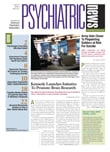Gay adolescents are three times as likely to report a history of suicidal ideation, suicidal intent, or suicidal attempts that require medical attention than are their straight peers.
The finding is from a meta-analysis of 19 studies looking at depression and suicide among children and adolescents that appears in the April 4 Journal of Adolescent Health, a publication of the Society for Adolescent Health and Medicine.
"The results underscore the need for clinicians treating youth and adolescents, whether they are gay or straight, to ask about sexual orientation and about suicidal thoughts or intentions, and to make sure that there are resources to intervene," lead author Michael Marshal, Ph.D., told Psychiatric News.
He is an assistant professor in the Department of Psychiatry at the University of Pittsburgh.
In the analysis, Marshal and colleagues conducted a systematic search of PsychInfo and MedLine to identify all studies published in 2009 or earlier using various combinations of key terms including "suicide," "depression," "gay," "lesbian," "LGB," and "adolescent." There were two criteria for the inclusion of studies in the meta-analyses: the studies must have reported rates of depression and/or suicidality among sexual minority and heterosexual youth, and their study samples had a mean age of 18 or less, with an upper boundary of the age range not exceeding 21 years.
Researchers identified and reviewed 378 abstracts to determine their eligibility, with the majority of ineligible studies excluded because they either focused on those aged 18 to 25, did not include a heterosexual comparison group, or were review papers.
Analysis of the 19 studies that met inclusion criteria revealed that, on average, 28 percent of gay teens reported a history of suicidality—including suicidal ideation, suicidal intent (defined as having a plan to commit suicide), actual suicide attempts, and attempts that required medical attention. This figure contrasts with 12 percent of heterosexual teens.
The analysis also showed that even after controlling for variables such as depression, low self-esteem, substance use, and conflict with family, gay and lesbian youth were still more than twice as likely to report a history of suicidality as were heterosexual youth.
Moreover, Marshal told Psychiatric News that the disparity in suicidality between gay and nongay youth increased with each level of severity—from ideation to actual attempts requiring medical attention. The odds ratio for suicidality among gay youth was 1.9 for ideation, 2.2 for intent, 3.18 for a history of attempts, and 4.17 for attempts requiring medical attention.
Overall, the odds ratio for any level of suicidality was 2.92 for youth who identified as being gay, according to the report.
Marshal told Psychiatric News that he had worked for several years in a clinic for adolescents with depression, many of whom had a history of suicidal thoughts or attempts, and was struck by the number of gay youth among his caseload. He added that he was intrigued to know whether the recent spate of news stories about suicide among gay youth were sensationalized or the reports represented a real trend.
The analysis would appear to confirm the markedly higher risk for suicidal thoughts, plans, or attempts among gay teenagers. He noted that all of the effect sizes for the various comparisons leaned in the direction of a higher risk for gay teens.
He emphasized the need for psychiatrists and mental health professionals treating adolescents to create a safe place for teens to talk about sexual orientation.
"All of us involved in care of adolescents have to provide a clinical context that is safe for young people to come out and to talk with their clinicians about sexual orientation without fear that they might be ‘outed’ to parents or other family members who might be involved in the clinical care of their teenagers."
